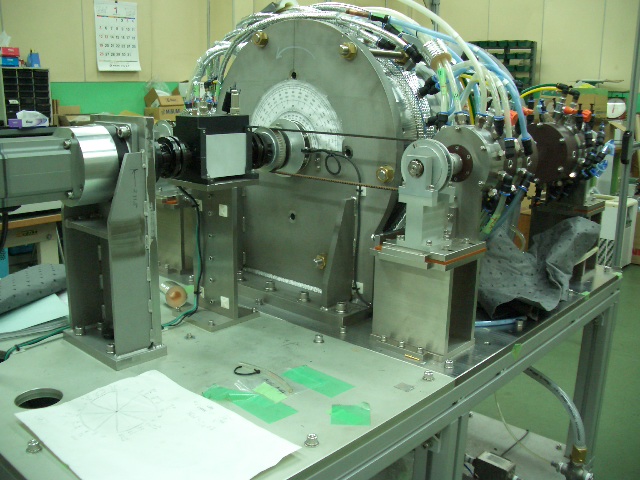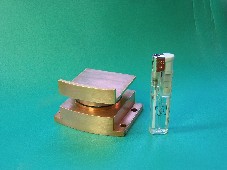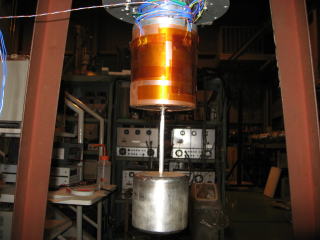Okamura Lab.
The research field of my laboratory is refrigeration and
cooling engineering. For instance, superconducting magnet
cooling technology, performance improvement of cryocooler
and recently we have been developing a room-temperature
magnetic refrigerator that is an environment-friendly new
type refrigerator.
Experiments are main means for our research. From one up
to three students are engaged on the respective subject.
Numerical simulations are also important to discuss on the
experimental results.
MAIN
RESEARCH

This refrigerator does not use chloro- fluorocarbon (CFC) or substitute CFC, while uses magnet-caloric effect. Some materials have this effect that heat generation and absorption are occurred when the materials are magnetized and de-magnetized. It is important to use magnet-caloric effect for cooling effectively.

A thermo-electric element, its electromotive force is a few millivolts, can supply a few hundred ampere current to a HTS magnet, because the electric resistance of HTS magnet is less than a few micro-ohm.
We have demonstrated an excitation of 1 tesla class HTS magnet using a thermo-electric element. The size of the element is only 3 cm x 3 cm square and 1.8 mm thick. This is so small and light compared with a conventional power supply for HTS magnet. We are exploring the applications of this system (e.g. for a plasma magnetic sail space craft, as a mobile magnet)

If we equip this device to a cryogenic system, refilling of refrigerant becomes no need. The vaporized gas is condensed in the upper part of the thermo-syphon using a cryocooler and the condensed refrigerant flows down to the storage vessel because of gravity. Development of thermo-syphon as small as we can and having larger condensation ability is going on.

February 18, 2023 at Ishiuchi Maruyama Ski Resort
Development of room-temperature magnetic refrigerator
This refrigerator does not use chloro- fluorocarbon (CFC) or substitute CFC, while uses magnet-caloric effect. Some materials have this effect that heat generation and absorption are occurred when the materials are magnetized and de-magnetized. It is important to use magnet-caloric effect for cooling effectively.

Development of high Tc superconducting (HTS) magnet excited by thermo-electric element
A thermo-electric element, its electromotive force is a few millivolts, can supply a few hundred ampere current to a HTS magnet, because the electric resistance of HTS magnet is less than a few micro-ohm.
We have demonstrated an excitation of 1 tesla class HTS magnet using a thermo-electric element. The size of the element is only 3 cm x 3 cm square and 1.8 mm thick. This is so small and light compared with a conventional power supply for HTS magnet. We are exploring the applications of this system (e.g. for a plasma magnetic sail space craft, as a mobile magnet)

Development of thermo-syphon working at cryogenic temperature
Refrigerants for superconducting magnets or devices, such as liquid helium and nitrogen, vaporize due to heat leakage from the ambient temperature surroundings. This thermo-syphon condenses the vaporized gas into liquid and returns it to a refrigerant-storage vessel.If we equip this device to a cryogenic system, refilling of refrigerant becomes no need. The vaporized gas is condensed in the upper part of the thermo-syphon using a cryocooler and the condensed refrigerant flows down to the storage vessel because of gravity. Development of thermo-syphon as small as we can and having larger condensation ability is going on.
February 18, 2023 at Ishiuchi Maruyama Ski Resort
INFORMATION
- March 14, 2023
- Due to retirement in March 2025, master's and doctoral course students cannot be accepted.
profile
Suzukakedai Campus G3-412 / okamura.t.ab[@]m.titech.ac.jp
〒226-8502
4259 G3-39, Nagatsuta-cho, Mifdori-ku, Yokohama